|
_________________________________
From 1835
Photogenic Drawing, Calotypes
and
Daguerreotypes
Photogenic Drawing
-
Talbot described his first experiments as photogenic
drawings.
They used no camera at all. He just placed
leaves, ferns and other objects on his photographic paper and exposed
it to light. The result was a negative image. The example
below was produced around 1835
Photogenic Drawing (Talbot)

©
Reproduced from the National Museum of Photography,
Film and
Television collection,
by courtesy of the Science and Society Picture
Library.
Click here for
link to web site.
Cameras
Later, Talbot used very simple cameras. These
were small wooden boxes with lenses. Note the small sizes.
The measure on the right is 3 ins.

©
Reproduced from the National Museum of Photography,
Film and
Television collection,
by courtesy of the Science and Society Picture
Library.
Click here for
link to web site.
-
Exposures of an hour or more would normally be
needed with these cameras. It was not practical to take
portraits!
-
The Calotype was an 1840 development of Talbot's
original discovery.
-
A Calotype might sometimes require an exposure of
as little as ten seconds but often it would need a minute, or perhaps
ten minutes, depending on the light.
Hill & Adamson
-
Here is a calotype of taken by Hill & Adamson
-
Their partnership began in 1843, but lasted for only
four years. Adamson died in early 1848:
'Edinburgh Ale'
James
Ballantyne, Dr George Bell & David Octavius Hill
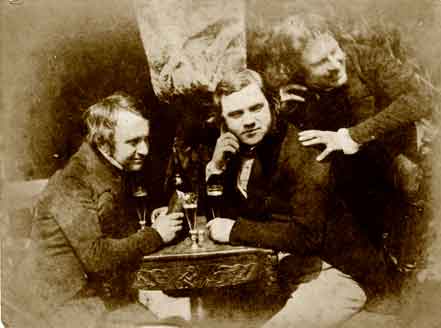
©
Reproduced
by courtesy of Edinburgh City Libraries and Information Services
Daguerreotype
See also 'Further Notes'
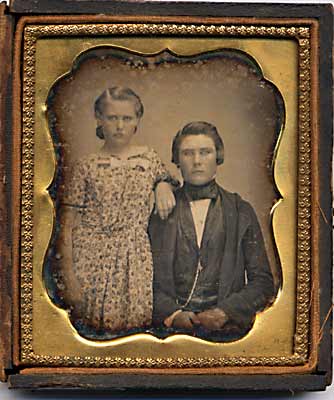 ©
©
-
This was the main process used for portraits in the
1840s, but the photos were expensive. Here, the image can be
clearly seen, but on tilting the photo a few degrees, the image almost
vanishes leaving what appears to be almost clear glass.
-
The Daguerreotype process needed skill and was
dangerous. It required a highly polished silver plate to be
exposed to:
-
iodine fumes before the photograph was taken
-
fumes from heated mercury after the photo had been
taken.
_________________________________
From
1851
Collodion Negatives
-
The collodion process required photographers to:
- coat
their glass plates in the dark THEN
- within about ten minutes, while
the surface of the plate was still wet
- take the photo and develop the plate.
-
So for outdoor photography dark tent or other form
of portable darkroom was
needed.
-
Here is a view of The Scott Monument, taken by George Washington Wilson of Aberdeen. The
vehicle beside the lamp post is his horse-drawn darkroom
parked outside the temperance hotel where he was staying in Princes Street.
Princes Street
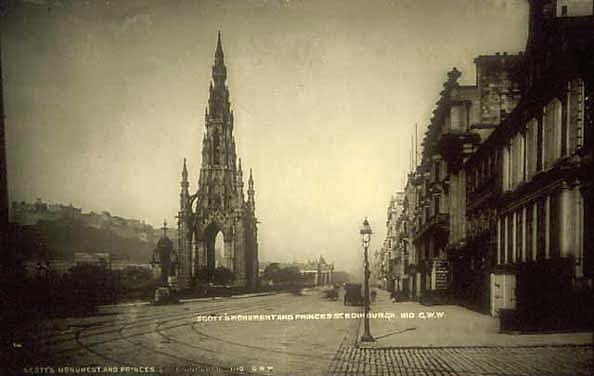
©
Queen
Mother Library - University of Aberdeen
Stereo Views
See also 'Further Notes'
-
Stereo views became popular in the 1850s.
The one below is of The Lord High Commissioner's Procession in
Edinburgh's Royal Mile in 1858.
-
Royal Mile - 1858
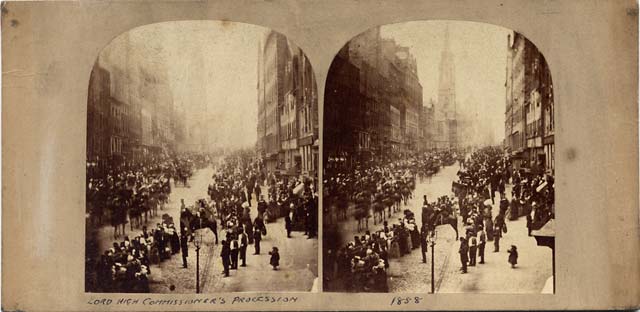
©
Copyright:
For
permission to reproduce, please contact peter.stubbs@edinphoto.org.uk
Cartes de Visite
-
The collodion process was much cheaper than the
Daguerreotype, so more photographers became established, and were able
to sell to a wider public. The normal size of portrait right up
to about 1900s were:
-
cartes de visite
(mounted on card 4.125ins x 2.5 ins)
from the mid-1850s
-
cabinet prints
(mounted on card 6.5ins x 4.25 ins)
from the mid-1860s.
-
Victorian photograph albums were produced to hold
these two sizes of print.
Carte de Visite
 ©
©
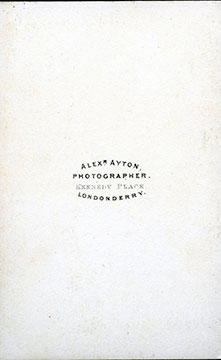 ©
©
-
Exposures of several seconds were needed for early
cartes de visite, so:
-
sitters were often supported by stands, or took
positions they could easily hold for several seconds.
-
sitters would be unlikely to be smiling
or showing expressions such as surprise.
Ambrotype
Ambrotype
Thomas Buist with wife and
daughter - 1857
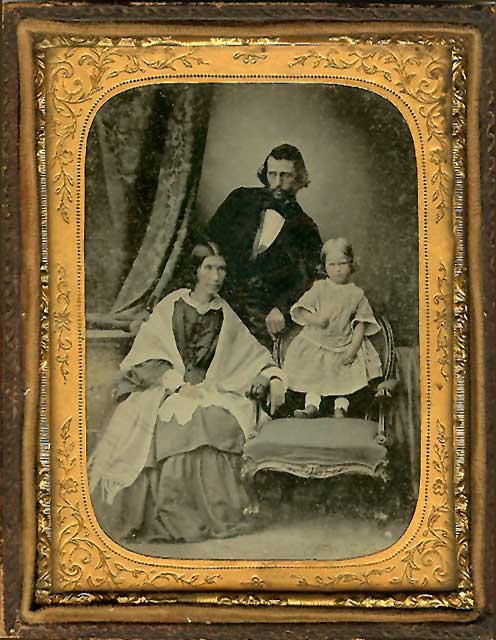
©
Reproduced with acknowledgement to Frances Culham, Bedfordshire, England
Ambrotype in a Union Case
The case is made from shellac
and sawdust, then moulded

©
Copyright:
For
permission to reproduce, please contact peter.stubbs@edinphoto.org.uk
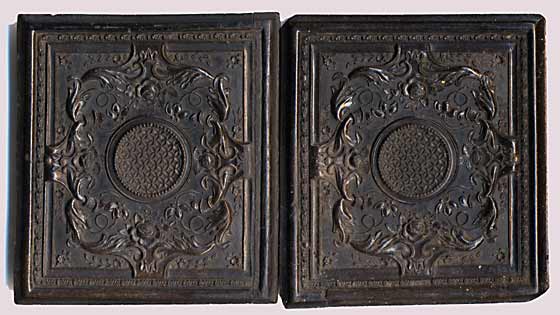
©
Copyright:
For
permission to reproduce, please contact peter.stubbs@edinphoto.org.uk
-
Tintype photos were similar to ambrotypes, but were
on metal, often very inexpensive and produced by itinerant
photographers. Some can be found unframed, others framed as for
Ambrotypes.
-
-
Albumen Prints
See also 'Further Notes'
-
From the 1850s onwards until near the end of the
century, Albumen prints were produced. These were a yellowish
colour and tended to fade.
-
Here is one of the Forth Bridge under construction.
in the 1880s.
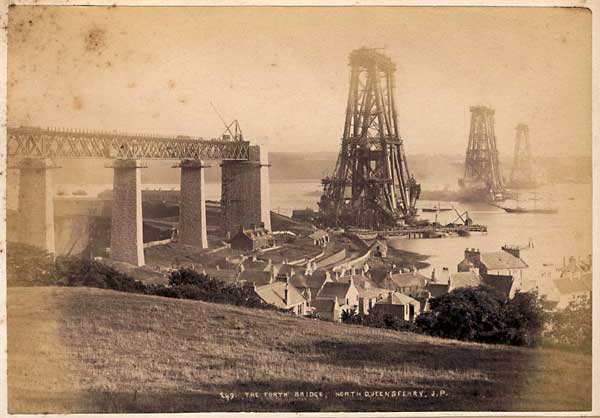
© Ray
Norman
________________________________
1880
to 1900
Amateur Photographers
See also 'Further Notes'
-
One of the most significant developments of the late
19th century was the move by photographers from the wet collodion to
the dry collodion process.
-
Hand-held
cameras
became popular, and were marketed to amateurs, particularly by Kodak.
In 1885, Kodak invented the roll film. In 1888, Kodak coined the
slogan "You Press The Button and We Do The Rest."
-
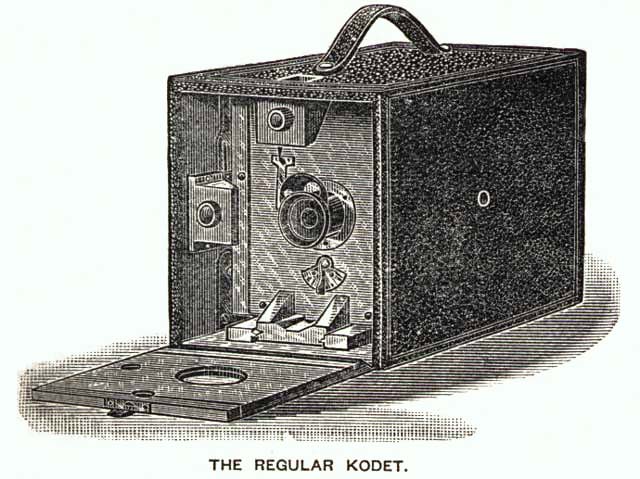
©
Reproduced
by courtesy of Edinburgh Photographic Society
-
The dry collodion plates were pre-coated, and did
not need to be processed immediately. They were also 'faster' so
could be used by amateurs using cameras without a tripod.
Professional Photographers
Cabinet Print
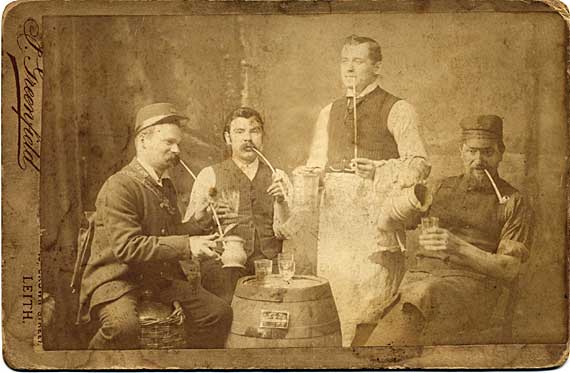
©
For
permission to reproduce, please contact peter.stubbs@edinphoto.org.uk

©
For
permission to reproduce, please contact peter.stubbs@edinphoto.org.uk
Stereo Views
Stereo Viewer - and view
of Grassmarket and Edinburgh Castle
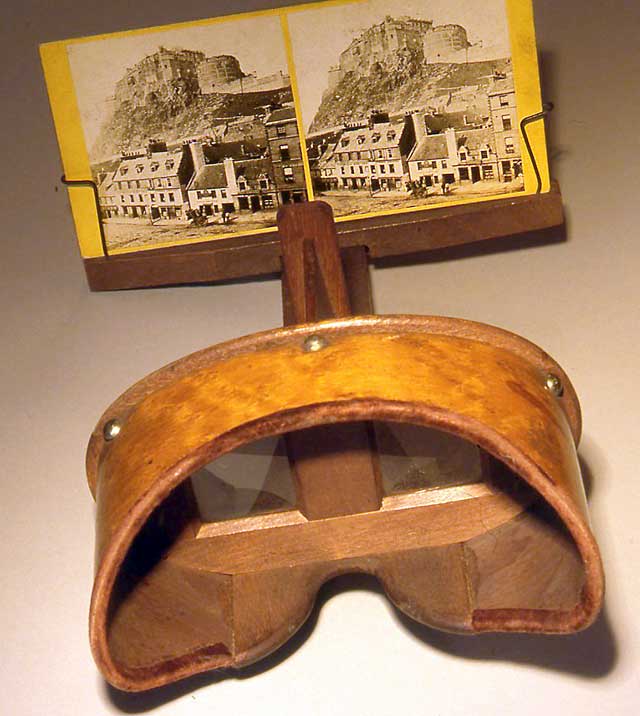
©
Copyright:
peter.stubbs@edinphoto.org.uk
Looking down the Mound
towards Princes Street

©
Copyright:
For
permission to reproduce, please contact peter.stubbs@edinphoto.org.uk
The Forth Bridge
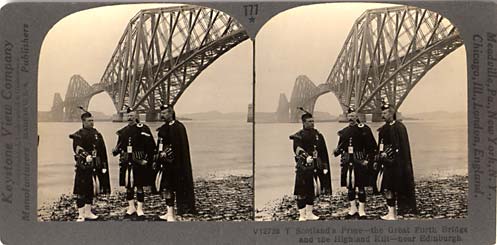
©
Copyright: For permission
to reproduce, please contact peter.stubbs@edinphoto.org.uk
Other Printing Methods
-
Other methods of printing began to be used instead
of albumen
-
Silver Bromide paper
came into use and remained popular in a variety of finishes throughout
the 20th century
-
Carbon and
Platinum and several
other processes were used in
order to produce prints that would not fade. Platinotype
materials became too costly, so very few were produced after 1914.
Platinotype Print
D & W Prophet - Dundee + St Andrew Square,
Edinburgh

©
please contact
peter.stubbs@edinphoto.org.uk
Photogravure Prints
See also 'Further Notes'
-
Thomas Annan took many photos of the slums of
Glasgow before they were demolished. Archibald Burns carried out
similar project for Edinburgh. Here are some of Annan's prints,
later reproduced as photogravures:
-
Photogravure - 1
Thomas Annan
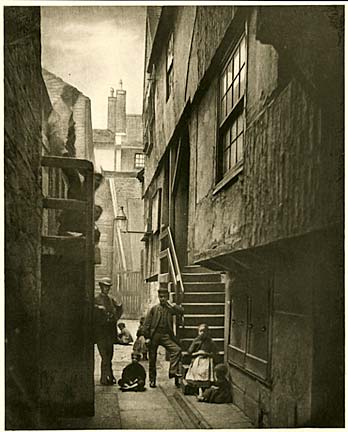
© Reproduced
with acknowledgement to Fine Art Dealer Paul Cava
Photogravure - 2
Thomas Annan
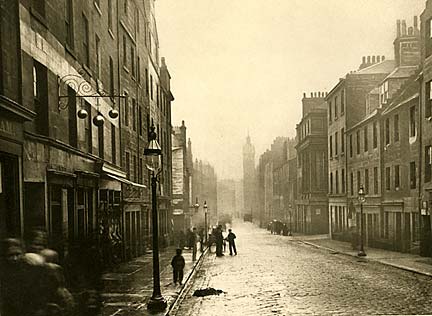
© Reproduced
with acknowledgement to Fine Art Dealer Paul Cava
Photogravure - 3
Thomas Annan
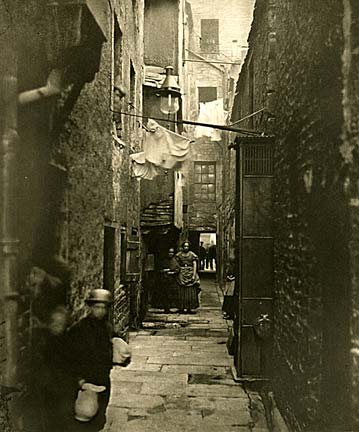
© Reproduced
with acknowledgement to Fine Art Dealer Paul Cava
________________________________
1900
to 2000
-
The bromoil printing
process was introduced in 1907. It remained popular with
pictorialists until the mid-20th century and is still practiced by a
few. A bromoil print involves replacing the emulsion on a print
with an oil-based pigment, using a hard, flat brush. The result
is a soft artistic image.
Bromoil
Dunure Castle, Ayrshire - J M Whitehead
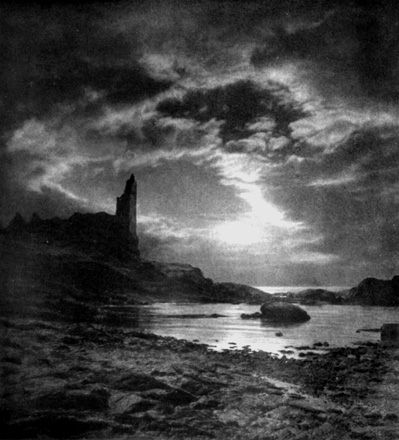
©
Reproduced with
acknowledgement to Ed
Romney
Documentary Photography
-
Here are a few documentary photos taken in the St
Leonard's district of Edinburgh. The locations of the last two
have not yet been identified.
1920s
Pleasance
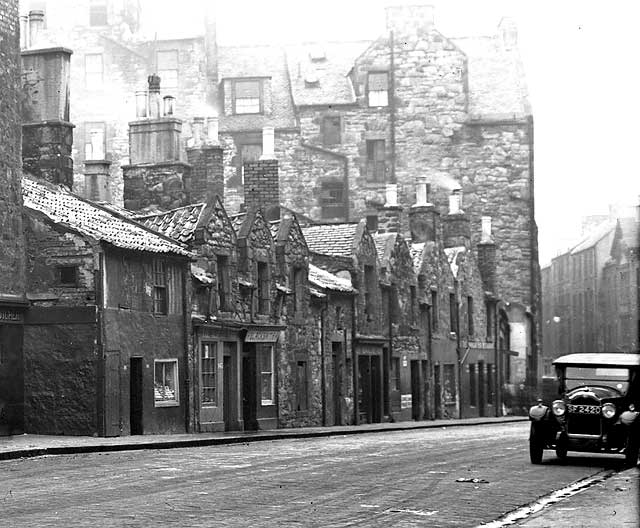
©
Reproduced with acknowledgement to David Gordon, Old Town, Edinburgh
1920s
Pleasance

©
Reproduced with acknowledgement to David Gordon, Old Town, Edinburgh
1920s
Pleasance

©
Reproduced with acknowledgement to David Gordon, Old Town, Edinburgh
Early-November 1927
East Crosscauseway
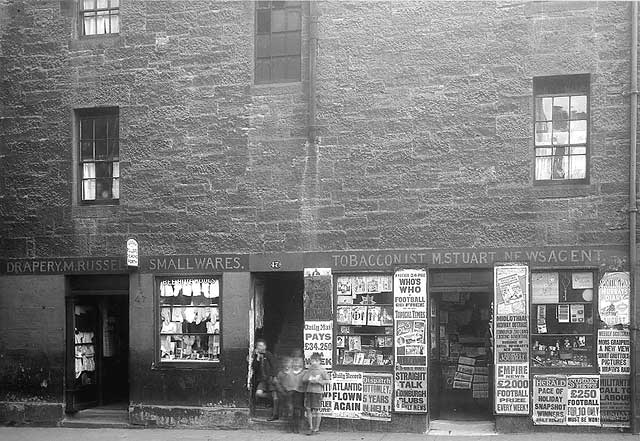
1920s
Where is it?
And here are a more 'where
is it?' photos
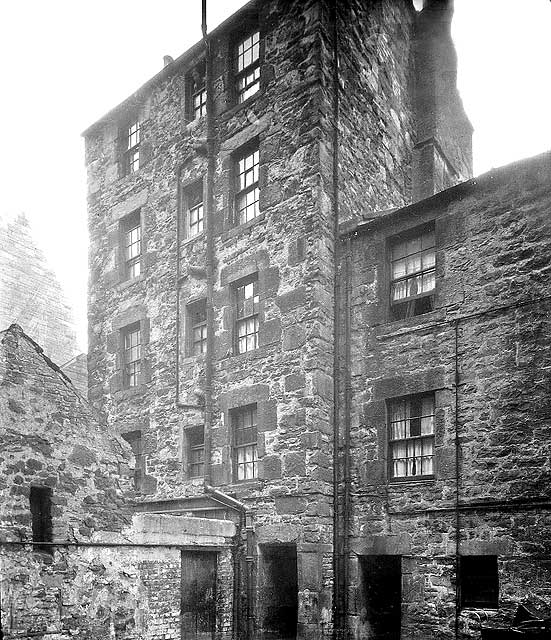
©
Reproduced with acknowledgement to David Gordon, Old Town, Edinburgh
1920s
Where is it?
And here are a more 'where
is it?' photos
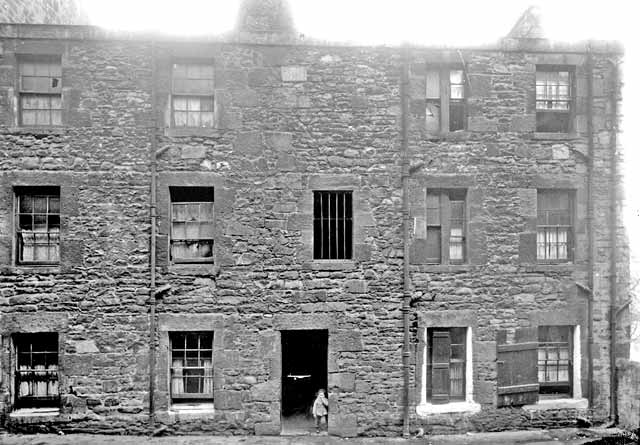
©
Reproduced with acknowledgement to David Gordon, Old Town, Edinburgh
Family Photographs
See also 'Further Notes'
-
Photography became more popular, but in the first
half of the 20th century it could be costly. There were still
many people and families who had no camera
and relied on studios like Jeromes.
-
There was a Jerome studio at 79 Leith Street from 1934 until 1970. They produced
affordable 'Postcard Portraits', though not many of these seem to have been sent through
the post.
-
Many people remember going to Jerome to have their photo taken
'beside the pillar' on birthdays, at end of term and on other occasions.
Jerome Studio
- Leith Street, Edinburgh:
1934 to 1970
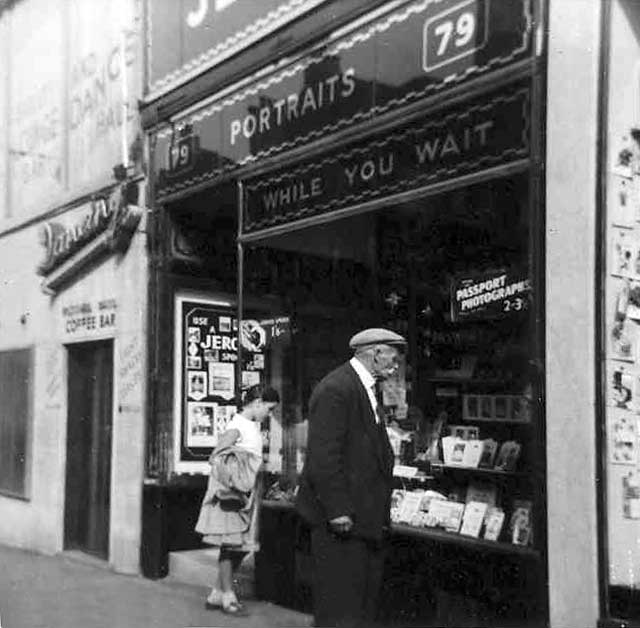
Later in 20th Century
-
Photography became more affordable. More
people and families began to own their own cameras that they used for
for black and white prints, and later for colour prints and slides.
-
As the century progressed, cameras became smaller
and easier to use. Even the Press replaced their old heavy glass
plate cameras by 35mm models.
-
Cameras continued to add new features and become
automatic.
________________________________
2000
to 2010
Digital Photography
Many photographers have moved to digital photography
since 2000. What is the impact of digital photography
likely to be?
-
More cameras over a wide range of prices. More photographers. No
cost of film. More photos taken.
-
More experimenting, as photographers are able to
take photos and view the results at short notice, without having to be
concerned about the cost of film.
-
More manipulated images:
-
Some photos will be changed to correct or improve
the brightness, contrast, etc. as might have been done in the darkroom
previously.
-
Some photos will be changed for artistic effect,
e.g. by use of Photoshop filters.
-
In some cases, reality will be altered, e.g. by
'cloning-out' unwanted items from the picture, or by combining two or
more photos, perhaps taken in different parts of the world.
-
Manipulation was possible in pre-digital days.
But it's far easier to do now.
-
Restored images can be produced from damaged prints,
using Photoshop
-
More immediate sharing of photos around the world,
through the internet.
-
Less long-term archiving of family photos, as photos
may be viewed then forgotten or deleted, rather than put in albums and
labelled.
-
What else?
|





























